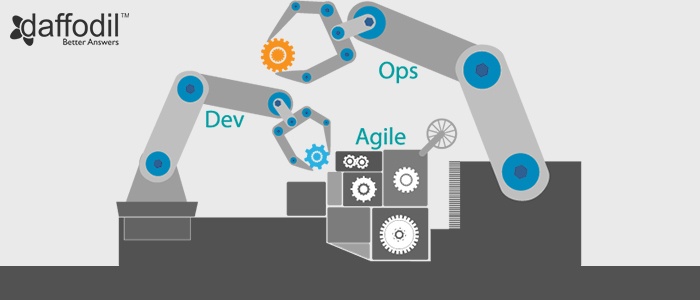
The Agile and DevOps theory is the topic of talk in IT organizations. However, there prevails a lot of confusion about the two, when it comes to differentiating between them and defining their benefits. Here, we try to understand the same with differences and similaries between both software development practices.
Software Development Cycle: Then and Now
Software development, when it was introduced as a technology advancement back in 1950s or 1960s, it forged ahead with a bang. At the outset, there were no rules and standards defined to validate the development approach.
Later, there was a rudimentary model that laid down the basis for software development and it was called the Waterfall model. This SDLC approach encourage developers to understand the user requirements thoroughly and then continue with design, development, and testing, until a fully-functional product is derived, following the pre-mentioned requirements.
While this seem to have worked out for a long time, this SDLC approach took the edge off versatility and reliability. This was because, as the projects started to scale, the client requirements shuffle (on the basis of priority for feature/functionality), user feedback, or technology adoption. Consequently, more time and money was wasted, resulting in a less efficient SDLC.
This limitation of the waterfall approach and developers lack of communication with other teams involved in product development resulted in experimenting with other SDLC approaches. Today, the most productive approaches that are being used to address the waterfall model limits and communication gap is Agile and DevOps. Let’s understand how.
- SDLC Agile Model
Agile is an umbrella term, which is given to the methodologies that follow iterative development. Such SDLC models ensure frequent delivery cycles, quick response to change, team work, and involvement of business to provide feedback or validate the output after short intervals. This is achieved by practices such as Scrum, Kanban, Pair Programming, Test-Driven Development/Behaviour Driven Development, Scaled Agile Frameworks etc.
According to Manifesto for Agile Software Development, an SDLC should have the following core values:
- Individuals and interactions over processes and tools
- Working software over comprehensive documentation
- Customer collaboration over contract negotiation
- Responding to change over following a plan
Against the Waterfall model of development, Agile do not believes in waiting for the final product for testing, feedback, or client approval. Following Agile methodology, developers divide the entire development cycle into small sprints, which further advocates continuous improvement, adaption to change, and evolving development (generally rendered through Minimum Viable Product (MVP)).
“Agile, iterative or lean methodologies are now used by 57% of software development teams.”
- DevOps
IT Operations (ITOps) and Development Operations (DevOps) are the two imperatives of an organization. While the IT handles security, regulations, and efficiency part, DevOps ensure seamless development and deployment of end-products.
DevOps is a business-driven approach for solution delivery, which could be a software development. It utilizes Agile practices, automation, and collaboration.
The DevOps services may range anywhere between implementation of tools and products, training or coaching, ongoing live service operations etc. This may include continuous integration (CI)m continuous deployment (CD), continuous delivery, platform support, or live service operations.
“A 2017 Gartner Research Circle survey indicates that one in three organizations source at least part of their agile and DevOps work from external service providers.”
Agile and DevOps: The Merger
Introduction to Agile methodology was a great relief for developers, when it comes to delivering to client’s expectations. However, this model for development was not perfect as well. Failing to deliver product on deadline, lack of necessary documentation, project getting off the track were some of the highlighted limitations of Agile methodology for software development.
To overcome these drawbacks of Agile, DevOps emerged as a solution, which was based up on communication between the development and IT operations team to ensure, secure, frequent, yet on time product releases. DevOps helped to maintain a culture that fortified communication between crossover teams like customer service, marketing, and at the same time takes care of a secure, stable system for product analysis.
When an Agile methodology for product development is followed, it involves developers, testers, and designers. With DevOps, there is an extension to the team with a IT Operations department. This way, process automation can ensure continuous integration, deployment, and delivery, thereby shrugging off the limitations of existing Agile model.
ALSO READ: 21 Tools to Implement Best Practices for DevOps
Agile and DevOps: Similarities and Differences
Agile and Devops share the similar goal of product development, with continuous improvement. However, there are certain factors that make these practices differ from each other. For example:
Team Work: For Agile methodology, there is one team and every member in the team has got a specialization that contributed to product delivery. On the other hand, DevOps has two teams at work, development and IT operations, working individually, but still in sync through seamless communication.
Team Size: For Agile, when smaller is the team, faster is the communication between them. On the other hand, DevOps involves small but multiple teams working in collaboration.
Task Timing: When developing a product using Agile methodology, there are short time intervals defined to complete a task. This is known as a Sprint and they dont last for long. Contrarily, DevOps has its goal of maximizing business efficiency and thus tasks are generally long term, causing least disruptions to business processes.
Documentation: For Agile development, meetings and discussions happen without documentation. On the other side, meetings for DevOps proper documentation to understand client’s requirements.
Adopting Agile DevOps for Software Development
DevOps is usually the tandem of Agile methodology. In simple words, it can be referred as a disciplined practice for Agile. We, at Daffodil believe in the outcomes of both the practices (Agile and DevOps) for software application development.
For our mobile app development projects, Agile methodology lay the basis. And to make solution delivery into a seamless process, we have been adopting mobile DevOps.
AlSO READ: What is mobile DevOps, its Challenges, and Ways to Overcome them
With DevOps as a service for software application development, we automate, optimize, and monitor your software development projects delivery pipeline with advanced tools and techniques.




